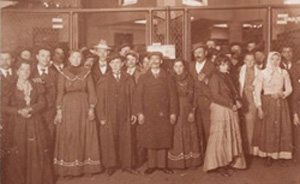talking history | syllabi | students | teachers | puzzle | about us
Immigration to the United States, 1789–1930
http://ocp.hul.harvard.edu/immigration/
Open Collections Project, Harvard University Library.
Reviewed May–Aug. 2007.
Harvard’s Open Collections Project (OCP) continues its quest to bring the best of Harvard University’s resources to users of the World Wide Web, this time by digitizing a large part of its collection on American immigration. Immigration to the United States, 1789–1930, offers access to 1,800 books and pamphlets and 13,000 pages from manuscript and archival collections, ranging from novels and diaries to legislative acts and union records. Add in the 9,000 photographs and 200 maps also digitized on the Web site and you have an archive of immense and lasting value to scholars, complemented by an easy-to-use organizational design.

On the railroad floor, these immigrants have been admitted
and are waiting to depart to their several destinations.
The sheer size of the archive means that it has something to offer most scholars of immigration. Particularly noteworthy are the vast holdings on the social, cultural, and political history of immigration on the East Coast, including both the experiences of immigrants and the varying reactions of the native-born. There is also outstanding documentation on topics ranging from Scandinavian settlements to the Chinese Exclusion Act. While the archival offerings have areas of weakness—the materials on Hispanic immigration, for example, are notably sparse—the organizers have attempted to compensate for these limits by compiling a usefully annotated set of links to other immigration sites.
The site is extremely user-friendly, offering multiple ways to access the archive, whether by browsing for individuals, genres, or topics; deploying a keyword search; or entering through a timeline. As with other OCP projects, this site also features a handy page delivery system (pds) that allows users to zoom in and out easily, to view documents as text or as image, and to print and store pages. Complementing the pds is a powerful search engine with a full-text option. One caveat is worth noting, however: the home page offers the option of browsing “photographs,” but most users will find it faster and easier to use the search engine to find images (those looking for maps should use that keyword in their searches).
While this archive is primarily aimed at researchers, two features appear to have been added with teachers in mind—a “themes” page and a timeline. Each theme focuses on a major event in immigration history, with a brief historical description, at least one image, and links to the most relevant resources in the collection, offering teachers immediate access to the topics they are most likely to cover in a class. The timeline is also useful, but it has one major flaw—it offers what appears to be links to major documents, but some of those links simply direct users to the collection’s most relevant holding (e.g., clicking on “the Anti-Coolie Act” brings you, not to the act, but to a pamphlet about the act), which might prove confusing to students at the introductory level.
That small quibble aside, the rich content and user-friendly design of this latest offering from the OCP should be of lasting value as a scholarly resource.
Tara Kathleen Kelly
Johns Hopkins University
Baltimore, Maryland
